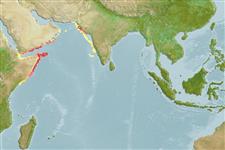Classification / Names
Common names | Synonyms | Catalog of Fishes(genus, species) | ITIS | CoL | WoRMS | Cloffa
Teleostei (teleosts) >
Acropomatiformes (Oceanic basses) >
Symphysanodontidae (Slopefishes)
Etymology: Symphysanodon: Greek, syn, symphysis = grown together + Greek, physis = growth body form + Greek, odous = teeth; related to few teeth which are located over the area where the two jaws meet (Ref. 45335).
Eponymy: Professor Dr William D Anderson Jr (d: 1933) was a marine biologist and ichthyologist at Grice Marine Biological Laboratory, College of Charleston, South Carolina. [...] (Ref. 128868), visit book page.
Environment: milieu / climate zone / depth range / distribution range
Ecology
Marine; benthopelagic; depth range 190 - 290 m (Ref. 54833). Tropical
Western Indian Ocean: known from a single specimen collected near mouth of Gulf of Aden, southwest of Socotra Island; reported from the Gulf of Kutch, an inlet in the NE quadrant of the Arabian Sea on the west coast of India.
Size / Weight / Age
Maturity: Lm ? range ? - ? cm
Max length : 15.7 cm SL male/unsexed; (Ref. 54833)
Life cycle and mating behavior
Maturity | Reproduction | Spawning | Eggs | Fecundity | Larvae
Anderson, W.D. and V.G. Springer, 2005. Review of the perciform fish genus Symphysanodon Bleeker (Symphysanodontidae), with descriptions of three new species, S. mona, S. parini, and S. rhax. Zootaxa 996(1):1-44. (Ref. 54833)
IUCN Red List Status (Ref. 130435: Version 2024-2)
Threat to humans
Harmless
Human uses
Tools
Special reports
Download XML
Internet sources
Estimates based on models
Preferred temperature (Ref.
123201): 13 - 17.8, mean 15.1 °C (based on 7 cells).
Phylogenetic diversity index (Ref.
82804): PD
50 = 0.5004 [Uniqueness, from 0.5 = low to 2.0 = high].
Bayesian length-weight: a=0.01000 (0.00244 - 0.04107), b=3.04 (2.81 - 3.27), in cm total length, based on all LWR estimates for this body shape (Ref.
93245).
Trophic level (Ref.
69278): 3.5 ±0.5 se; based on size and trophs of closest relatives
Fishing Vulnerability (Ref.
59153): Low vulnerability (10 of 100).
